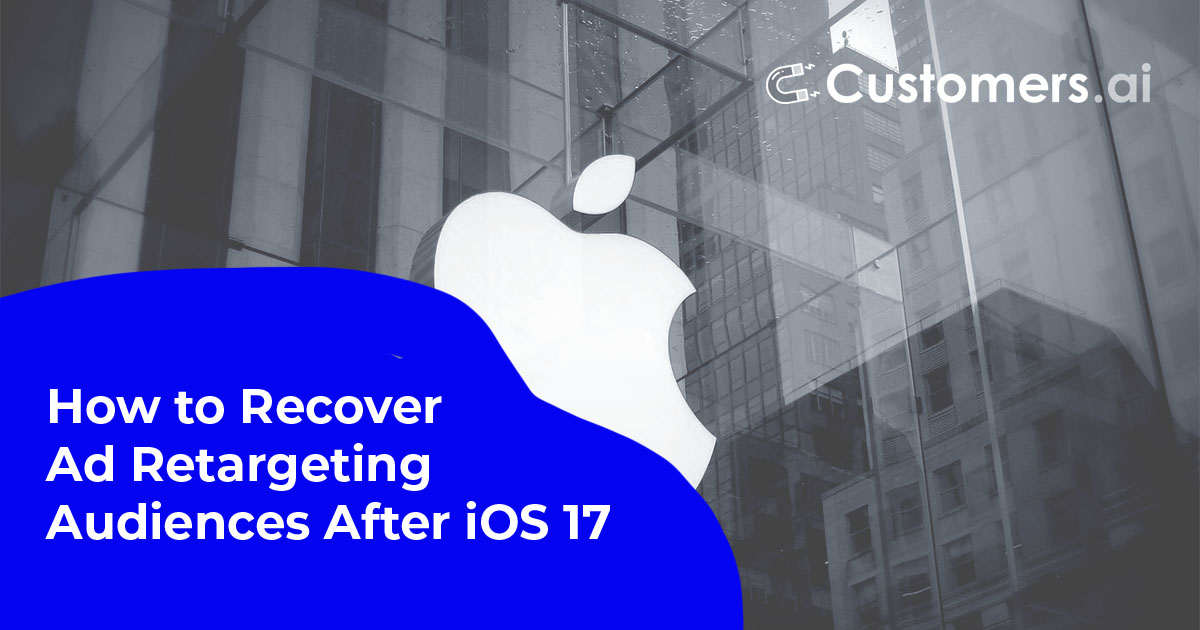Back in 2020, Apple launched iOS 14 in what was a huge shock to the advertising ecosystem. iOS 14 allowed users to opt out of tracking and opt-out they did. The latest statistics show that only 34% of iOS users remain opted-in.
While the release of iOS 14 didn’t completely destroy the digital advertising landscape like many feared, it did add a new layer of complexity. With significantly less audience data, retargeting on channels like Google Ads and Facebook became more complicated and less fruitful.
Now, with iOS 17 having been released and tracking links being stripped, audiences are shrinking even further.
Fear not though. Despite what appears to be gloom and doom, there are ways advertisers can recover ad retargeting audiences and keep campaigns running more efficiently than ever before.
Understanding the iOS 17 Update & Its Impact on Advertising
There are plenty of feature changes and new elements in iOS 17 (Hello Live Voicemail!). You can find those here. For our purposes, we want to look at the key change impacting advertisers and specifically ad retargeting.
The biggest change with the launch of iOS 17 is the introduction of Link Tracking Protection. From Apple’s press release:
“Some websites add extra information to their URLs in order to track users across other websites. Now this information will be removed from the links users share in Messages and Mail, and the links will still work as expected. This information will also be removed from links in Safari Private Browsing.”
Not ideal for advertisers. The good news (for now) is that email campaigns shouldn’t be impacted, specifically if you are using an email marketing platform that appends UTMs after a link redirect. Additionally, parameters such as Source, Medium, and Campaign will not be stripped as they are not personal identifiers.
3 Steps to Recovering Ad Retargeting Audiences After iOS 17
There is no time like the present to start recovering your ad retargeting audiences and Customers.ai is the solution to do this. With our Website Visitor X-Ray tool, you can identify the name, contact info, and intent signals of your anonymous visitors and use that data to build retargeting audiences for your digital ad platforms. This means you can reach the people who are most likely to convert. Even better, you can get started in three easy steps:
1: Install the Website Visitor ID X-Ray Pixel
The Website Visitor ID X-Ray easy to install and can be done in about 90-seconds. We have several ways to install it including GTM, Shopify, WordPress, and more.
In the dashboard, navigate to My Automations, select + New Automation, and get your pixel. Make sure to test it to verify it’s working. Bonus: You can select which page/s you want to track for even more specific targeting.
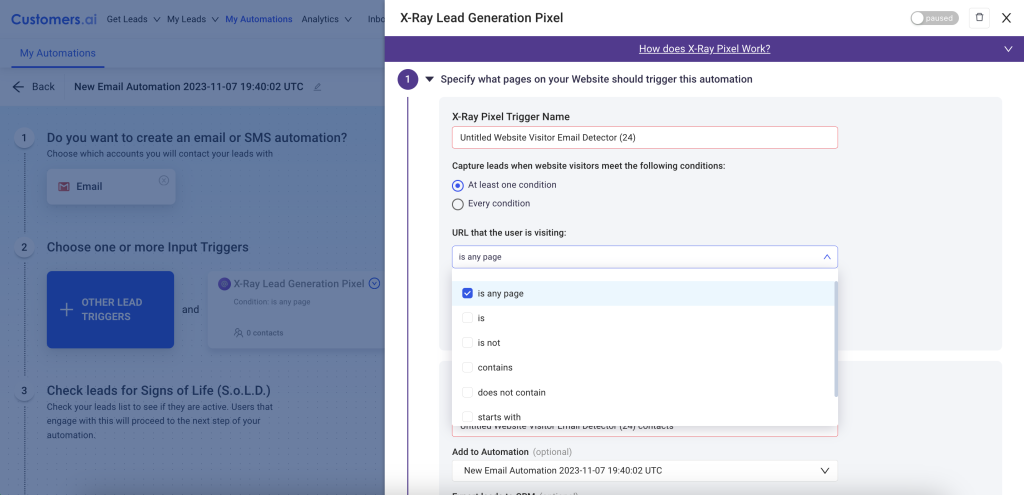
2. Export Your Audience of X-Ray Visitors
The key to building your ad retargeting list is in your X-Ray list. To export your list of website visitors, navigate to My Leads, choose “X-Ray”, and select the visitors you want to export.

Want to learn more about your visitors or create additional segments? Each visitor contains information like email, first and last name, the page they landed on, how many times they visted, and more.
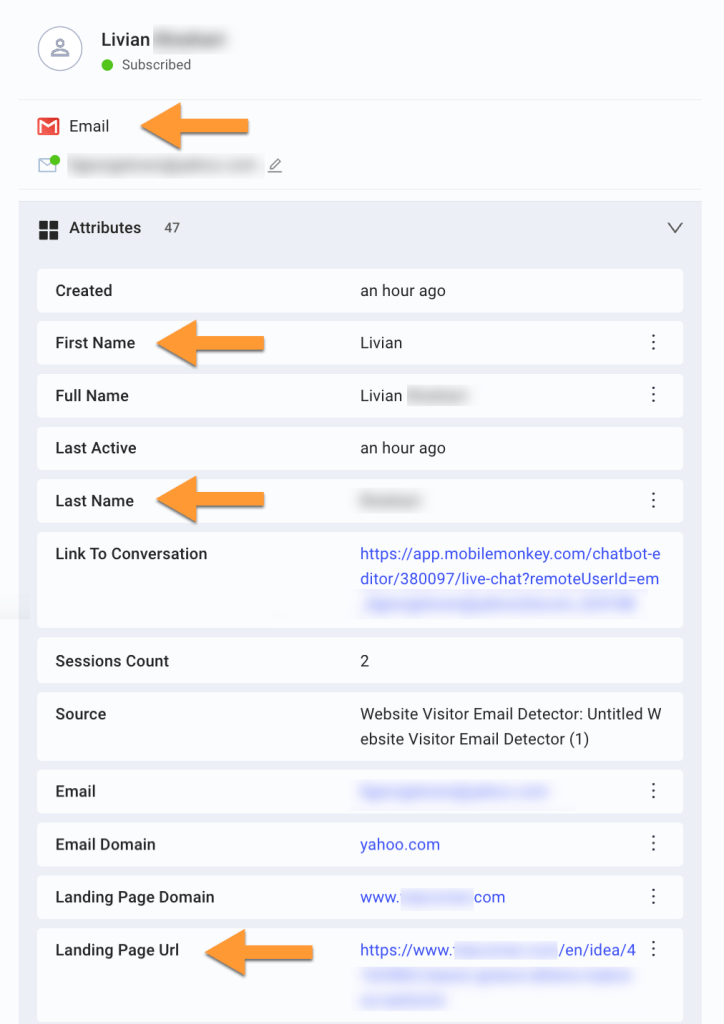
3. Upload Your Export As a Custom Audience in Your Ads Platform or Sync Directly to Facebook
Once you have your audience lists exported and created, upload them into your ads platform (ex: Google Ads).
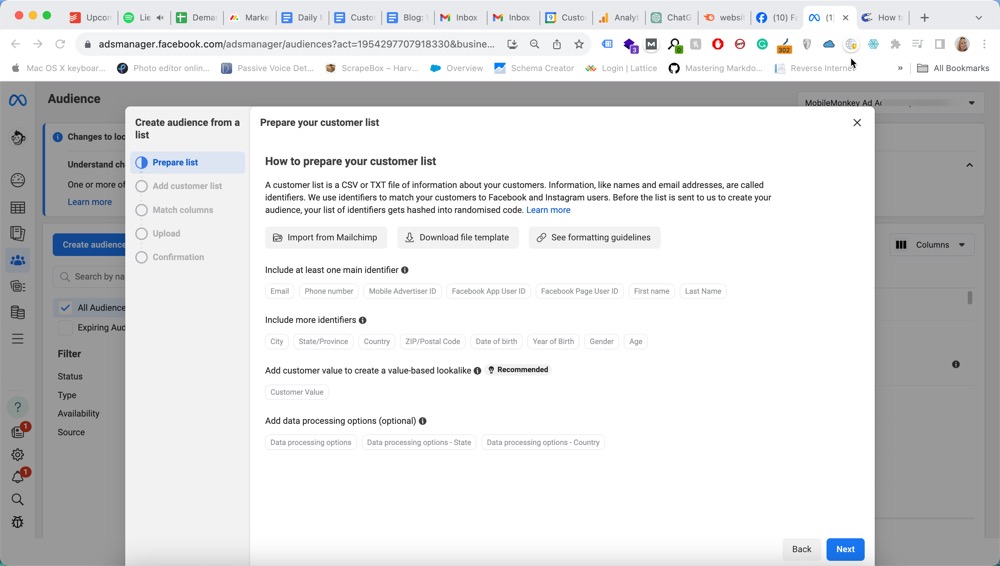
If you are running Facebook Ads, you can create a custom audience directly in the Customers.ai platform and sync to Facebook. To get started, go to Integrations and look for the Facebook tab.

Log into Facebook, connect your Facebook business page (if it’s not already connected), and select an ad account.
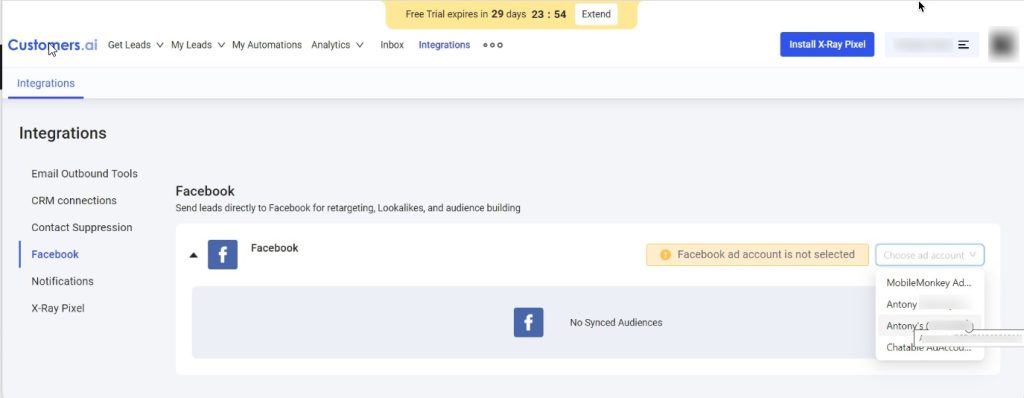
From there, you can create an audience.
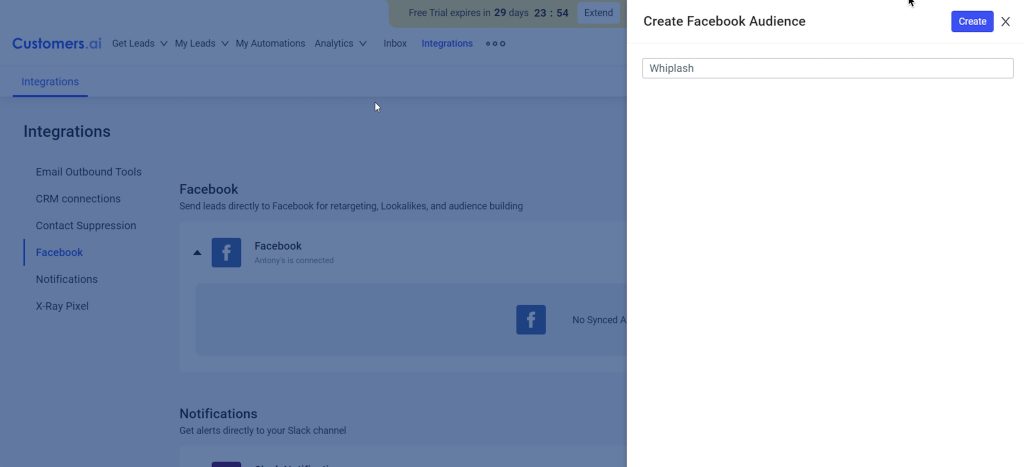
And start syncing. Just like that!
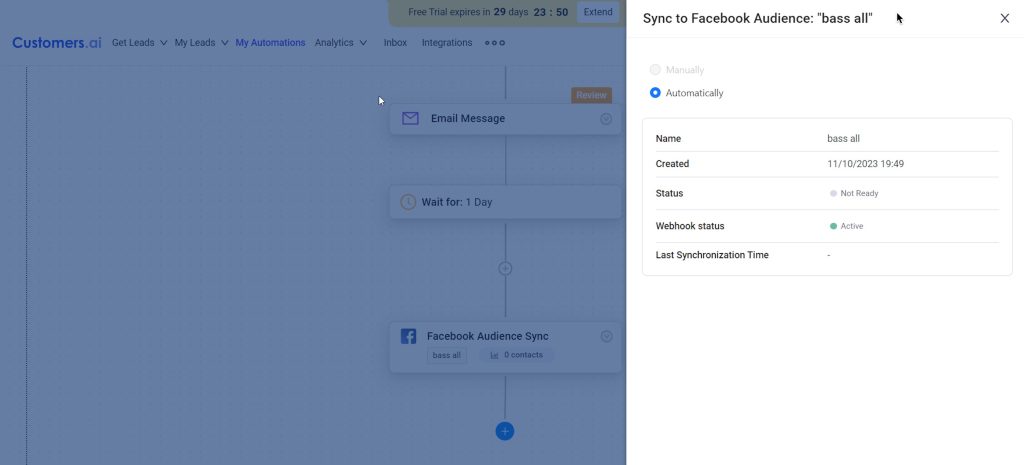
With Customers.ai, you can not only grow your retargeting lists, but ensure you are targeting people who are already interested in what you have to offer!
Now that we have the important part taken care of, read on for more information on how iOS 17 is impacting advertisers and what you need to be thinking about.
Convert Website Visitors into Real Contacts!
Identify who is visiting your site with name, email and more. Get 500 contacts for free!
How Does iOS 17 Impact Ad Retargeting?
There are two main considerations here: Retargeting and Remarketing Audiences.
- Retargeting: Any retargeting campaign that relies on click IDs will be impacted by iOS 17. Without the click ID data, ad platforms like Google and Meta will have a hard time detecting if a user should be retargeted to.
- Remarketing Audiences: Remarketing audiences are built on previous interactions a user had with you – email clicks, Google Ads clicks, Meta Ads clicks, etc. Without click IDs, the platforms are going to have a much harder time identifying who should be placed on the remarketing list and audience lists are going to become much smaller.
How Can Marketers Recover Ad Retargeting Audiences?
If you’ve been paying attention in recent years, these iOS updates shouldn’t surprise you. Privacy is a top concern for companies like Apple and Google and we know they will continue to make changes that make the life of marketers and advertisers much harder.
We also know marketers are great at adapting. We’ve seen the push toward first-party data, the embrace of new technology to capture that data, and the changes in strategies to ensure budget is being put toward measurable channels.
Let’s dig into a few strategies advertisers can employ to recover ad retargeting audiences:
1. Look to Collect Zero-Party Data
If you haven’t heard the phrase ‘zero-party data’, it refers to the information your customers, website visitors, or email subscribers give to you. For example, form data, survey responses, chat messaging, and customer profiles are all considered zero-party data.
This is the kind of data that when used properly, can help grow your ads retargeting list and lead to some phenomenal personalization on both the ads and email side of things.
For example, with the Customers.ai AI email writer, you can use this exact type of data to send dynamically AI-generated, hyper-personalized remarketing emails that drive engagement.
In the screenshot below, you can see we know an address, we know there is an interest in startups, and we know this user has two kids. The AI email writer puts that into one highly-targeted (and interesting!) email.
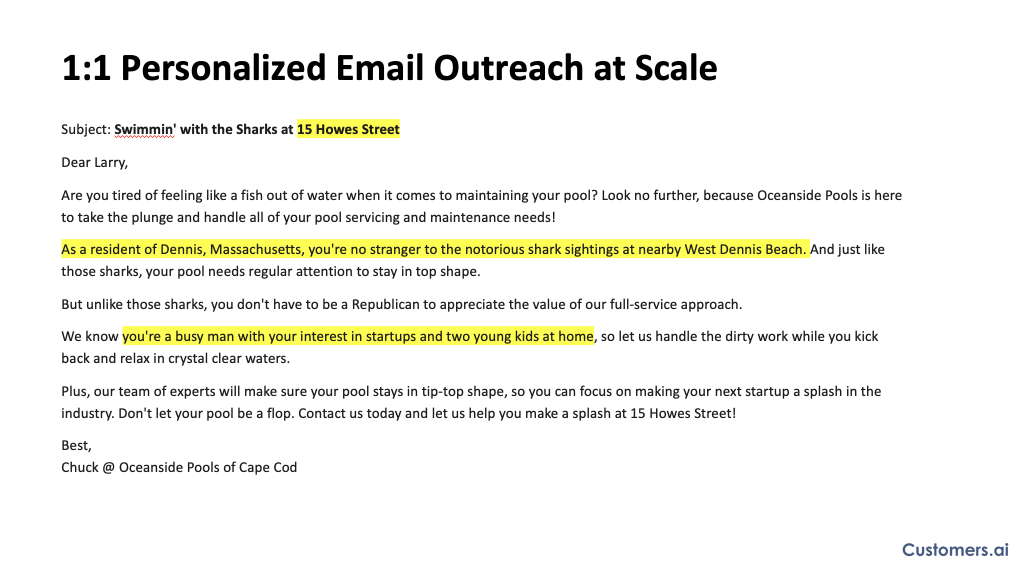
Zero-party data not only allows you to build your ads retargeting list but also allows you reach those users in a better way.
2. Utilize Your First-Party Data
First-party data has always been valuable. After all, first-party data is your data. It’s the data you’ve collected from your customers or visitors. It’s information like email addresses, purchase history, or browsing data. First-party data allows you to measure more effectively and it allows you to create effective remarketing audiences.
For example, if you are an ecommerce clothing retailer, first-party data can tell you individual A added a pair of pants to his cart and left without checking out. We can then ensure that individual is put into a retargeting campaign and served ads for the product he abandoned.
But what if there is way to capture even more first-party data about our visitors?
What if we can capture the email addresses of people who visit our website but don’t take an action? What if we can identify visitors who simply visit our site? Wouldn’t that lend to an exponential increase in our ads retargeting audiences?
The answer is YES and that is exactly what the Customers.ai X-Ray tool does.
By adding a simple pixel to your site (which you have hopefully already done), you can start collecting email addresses and building audiences immediately.
Customers.ai X-Ray tool changes the landscape when it comes to first-party data and helps advertisers recover (and more importantly, expand) the ads retargeting audiences being lost to iOS 17.
Now, what’s important to remember with both zero-party and first-party data is a strong CRM is essential. In this world of cookieless retargeting, your audience lists are only as good as the data behind them.
3. Explore Contextual & Interest-Based Audiences
The last strategy we want to discuss is contextual and interest-based audiences. While contextual advertising hasn’t always been the belle of the advertising ball, the privacy changes being made by companies like Apple is leading to a resurgence. In fact, according to the Contextual Advertising – Global Market Trajectory & Analytics report, the contextual advertising market is set to reach $335.1 billion by 2026, growing at a CAGR of 13.3%.
What makes contextual advertising interesting is that your ad isn’t being shown on a random site. It is being shown on a related site – a site that is “contextually” similar to your product or service. You can target by category, keywords, or even semantics, giving you a variety of ways to reach your audience.
Now you might be wondering, how does this help us recover our ad retargeting audience?
Simple. Customers.ai has a database of over 250M U.S. shoppers, broken out by demographics, buying behavior, and interests. By building these into your audience lists, you can find and target new customers effectively. You can utilize contextual advertising to reach these individuals and bring them into the fold.
Moving Forward…
The changes brought by iOS 14, iOS 17 and certainly future releases mean advertisers have to think of new ways to reach their customers. As privacy changes evolve, your ad retargeting lists will likely continue to shrink unless you take action.
With Customers.ai, you can not only recover those audiences but you can grow them even larger, opening up new opportunities and increased revenue. Learn who’s visiting your website right now and add them to your Facebook or Google retargeting audience — for FREE!
Important Next Steps
- See what targeted outbound marketing is all about. Capture and engage your first 500 website visitor leads with Customers.ai X-Ray website visitor identification for free.
- Talk and learn about sales outreach automation with other growth enthusiasts. Join Customers.ai Island, our Facebook group of 40K marketers and entrepreneurs who are ready to support you.
- Advance your marketing performance with Sales Outreach School, a free tutorial and training area for sales pros and marketers.
Convert Website Visitors into Real Contacts!
Identify who is visiting your site with name, email and more. Get 500 contacts for free!
Ad Retargeting Audience FAQs
Q. How does iOS 17 affect ad tracking for marketers?
iOS 17 introduces Link Tracking Protection, removing extra information from URLs to enhance user privacy. For marketers, this means a limitation on tracking and attributing user interactions across platforms.
Q. Will iOS 17 impact ad retargeting efforts?
Yes, iOS 17’s Link Tracking Protection affects ad platforms’ ability to track user interactions by removing Click ID data, making ad retargeting campaigns more challenging.
Q. What are the consequences of the removal of click IDs in iOS 17 for marketers?
The removal of click IDs makes it difficult for ad platforms like Google and Meta to track and retarget users, leading to a significant impact on ad campaign attribution and targeting along with smaller audiences.
Q. How can marketers adapt to the shrinking retargeting audiences due to iOS 17?
Marketers can recover ad retargeting audiences by focusing on collecting zero-party data and utilizing first-party data more effectively. They can also explore contextual and interest-based audiences to reach new customers.
Q. What is zero-party data, and how can it help marketers recover retargeting audiences?
Zero-party data refers to information voluntarily provided by customers, visitors, or subscribers. It can help marketers build retargeting lists and improve personalization in ads and emails.
Q. What role can zero-party data play in AI-generated email campaigns?
Zero-party data can enhance AI-generated email campaigns by providing valuable insights for creating hyper-personalized emails that drive user engagement.
Q. How does first-party data help marketers create effective remarketing audiences?
First-party data, including email addresses, purchase history, and browsing data, enables marketers to measure effectively and build remarketing audiences. It allows for tailored ad campaigns targeting users based on their actions.
Q. What is a retargeting audience, and why is it important for my online marketing strategy?
A retargeting audience comprises users who’ve previously engaged with your content or website. It’s vital for online marketing as it allows you to re-engage with prospects who’ve shown interest, increasing conversion rates and ROI.
Q. How can I create a retargeting audience for my website?
Create a retargeting audience by using platforms like Google Ads or Facebook Ads. Install tracking code on your site, collect user interaction data, and segment audiences based on behavior, such as page visits or cart abandonment.
Q. What are the benefits of capturing more first-party data from website visitors?
Capturing email addresses from visitors who don’t take immediate action on a website can significantly expand ad retargeting audiences and increase the effectiveness of campaigns.
Q. How does Customers.ai’s X-Ray tool contribute to first-party data collection?
Customers.ai’s X-Ray tool simplifies first-party data collection by adding a pixel to websites, allowing advertisers to collect email addresses and build audiences efficiently.
Q. Why is a strong CRM crucial for effective retargeting in a cookieless environment?
In a cookieless retargeting world, a strong CRM system is essential as audience lists are only as effective as the quality of data within them, ensuring effective targeting and personalization.
Q. What are contextual and interest-based audiences, and how can they help recover retargeting audiences?
Contextual and interest-based audiences involve showing ads on related sites or to users with specific interests. Marketers can utilize these audiences to reach new customers effectively and regain their retargeting audiences.
Q. How does contextual advertising work, and why is it gaining importance for marketers?
Contextual advertising targets users on sites related to their interests or the product or service being advertised. It is gaining importance due to increasing privacy concerns and is expected to reach a market value of $335.1 billion by 2026.
Q. Why should marketers be proactive in adjusting their strategies to accommodate iOS updates like iOS 17?
Marketers should adapt to iOS updates as privacy changes and restrictions evolve, impacting ad retargeting lists. Being proactive is essential to maintain and grow their retargeting audiences.
Q. What can marketers do to ensure the recovery and expansion of their ad retargeting audiences?
Marketers can recover and expand their ad retargeting audiences by collecting zero-party data, utilizing first-party data effectively, and exploring contextual and interest-based audiences to reach new customers effectively.
Q. What is the significance of first-party data for marketers in creating remarketing audiences?
First-party data, including email addresses, purchase history, and browsing data, empowers marketers to build effective remarketing audiences and craft tailored ad campaigns.
Q. How can capturing more first-party data from website visitors expand retargeting audiences for marketers?
Capturing email addresses from visitors who haven’t taken immediate action on a website can significantly increase ad retargeting audiences, providing more opportunities for engagement.
Q. What are some best practices for growing and expanding my retargeting audience effectively?
Optimize ad campaigns for engaged segments, diversify ad creatives, segment audiences based on behavior and interests, use first-party data, utilize identify resolution tools, and consider contextual advertising.
